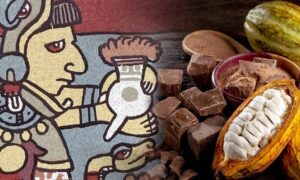Doctor Curmudgeon® A Confection With a Dark Side
By Diane Batshaw Eisman, M.D. FAAP Doctor Eisman is in Family Practice in Aventura, Florida with her partner, Dr. Eugene Eisman, an internist/cardiologist
I am relaxed.
I am comfortable.
An excellent book lies in my lap, waiting for me to open it and begin reading.
I sigh with peace, contentment and joy as I reach for an enchanting square of simple dark chocolate.
As it approaches my mouth, I begin to wonder. What is the history of chocolate? Did some genius suddenly say “Ah Hah?” Or did it have a long path to its appearance on shelves all over the world? And, finally is there a darker side to its production?
Wikipedia comments that the history of chocolate goes way back, more than five thousand years.
It has been thought that cocoa beans were initially harvested about 5300 years ago in Ecuador, as traces of cocoa have been unearthed in Ecuadorean pots.
The Olmecs, an early civilization in Southern Mexico were the first to use them in their ceremonial drinks. They harvested the beans from sheaths which hung from tree branches.
In the beginning, cocoa beans made a bitter drink that had to be spiced up with a bit of mashed corn. It was regarded as an aphrodisiac and also purported to give great strength to whoever drank it.
The Olmecs then passed on their knowledge of cocoa beans to the Mayans, who used it regularly. Mayans disseminated chocolate throughout their culture. Rich or poor enjoyed chocolate drinks with their meals. It was ubiquitous, being used to celebrate business transactions and was imbibed at important celebrations such as marriages.
The Mayans even used the cocoa beans as currency for their purchases.
Some tales relate that it was Christopher Columbus who brought cocoa beans to Spain in 1502. Others credit Spanish conquistador Hernan Cortes who enjoyed it in 1519 at the court of Montezuma.
By whatever means, it did arrive in Spain in the sixteenth century where it was used as a beverage to alleviate stomach pain. Sugar was added to counteract its bitterness and the wealthy began to use it as a mark of the privileged class.
Steam engines and mechanical coca grinders came along and chocolate could now be refined on a larger scale. It spread across Europe and eventually became popular among “common” people. Cadbury began to produce boxes of chocolates around 1868 in England.
Benjamin Franklin sold chocolate in Philadelphia in 1739 0r 1735. Although the exact year is unclear, the site of sale is well known to have been his printing shop.
A turning point came in chocolate production in 1893 in Chicago. This was the site of the World’s Columbian Exposition. Milton S. Hershey was a Pennsylvania candy maker and entrepreneur. He was interested in production methods and thought the Exposition was an opportunity to review modern methods. Fascinated by a demonstration of German chocolate equipment, he purchased it and had the machinery shipped to Pennsylvania. The Hershey Chocolate company was established in 1894.
There is a very dark side to the production of chocolate. Much chocolate is being produced in West African countries. There are companies who use child labor and trafficking and are unconcerned about environmental harm with their use of agrichemicals and deforestation.
Kimberly Hickok with contributions from Jessie Szalay writes on the website, Live Science; “According to Slave Free Chocolate, hundreds of thousands of children work in chocolate production in West African countries, where they are vulnerable to trafficking, slavery and other violent labor practices. The International Labor Rights Forum reports that these children are often exposed to chemicals, work long hours and are denied education.
“Consumers who want ethical chocolate should look for certifications designating Fair Trade, Rain Forest Alliance, UTZ, and Fair for Life, according to Slave Free Chocolate’s guide to chocolate companies.”
This is the link to the Slave Free Cholate’s guide.
Dr. Curmudgeon suggests “Bitter Medicine”, Dr. Eugene Eisman’s story of his experiences–from the humorous to the intense—as a young army doctor serving in the Vietnam War.
Bitter Medicine by Eugene H. Eisman, M.D. –on Amazon
Doctor Curmudgeon® is Diane Batshaw Eisman, M.D., a physician-satirist. This column originally appeared on SERMO, the leading global social network for doctors.
SERMO www.sermo.com
Click Here to Order Boxing Interviews Of A Lifetime By “Bad” Brad Berkwitt


